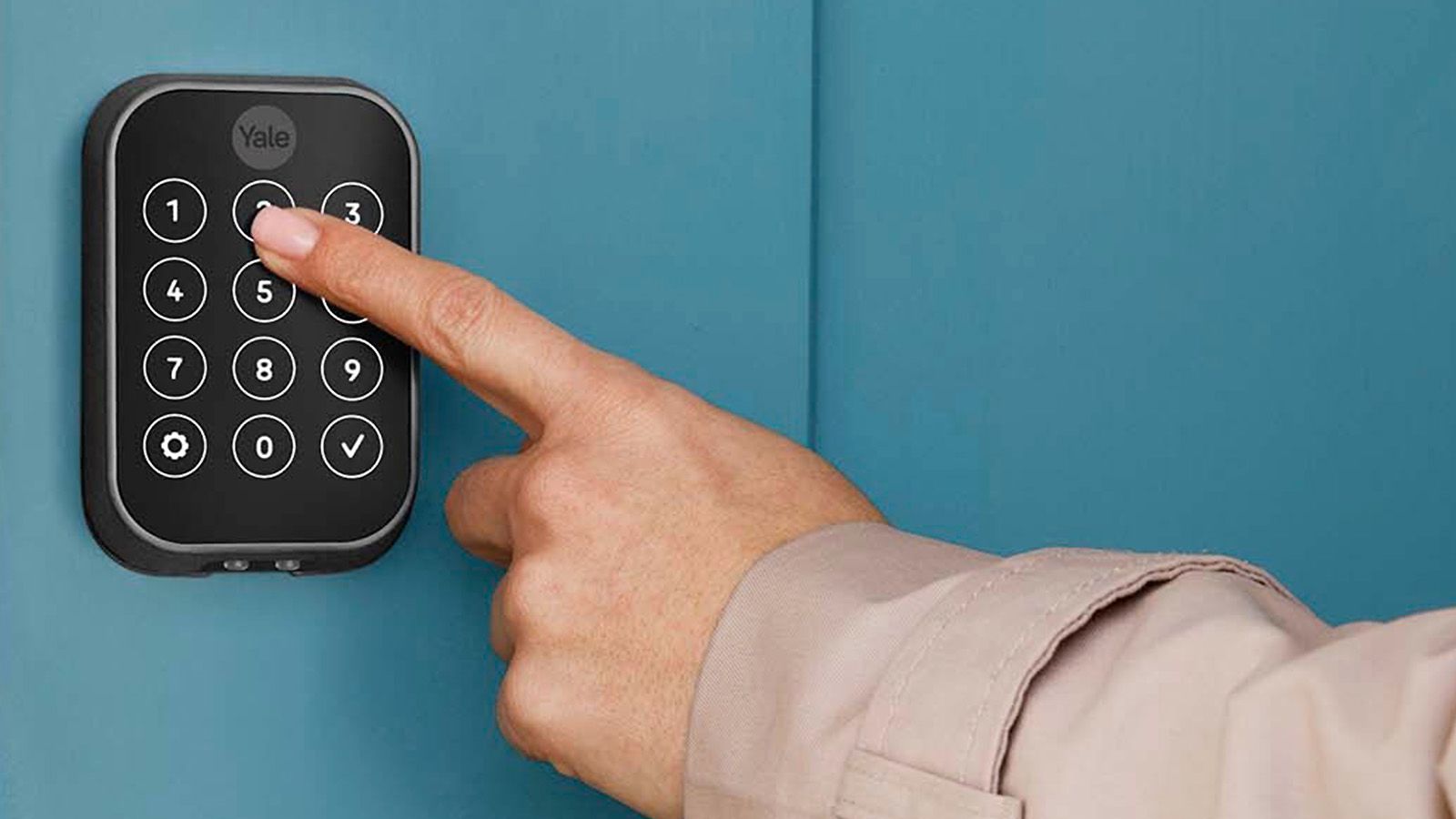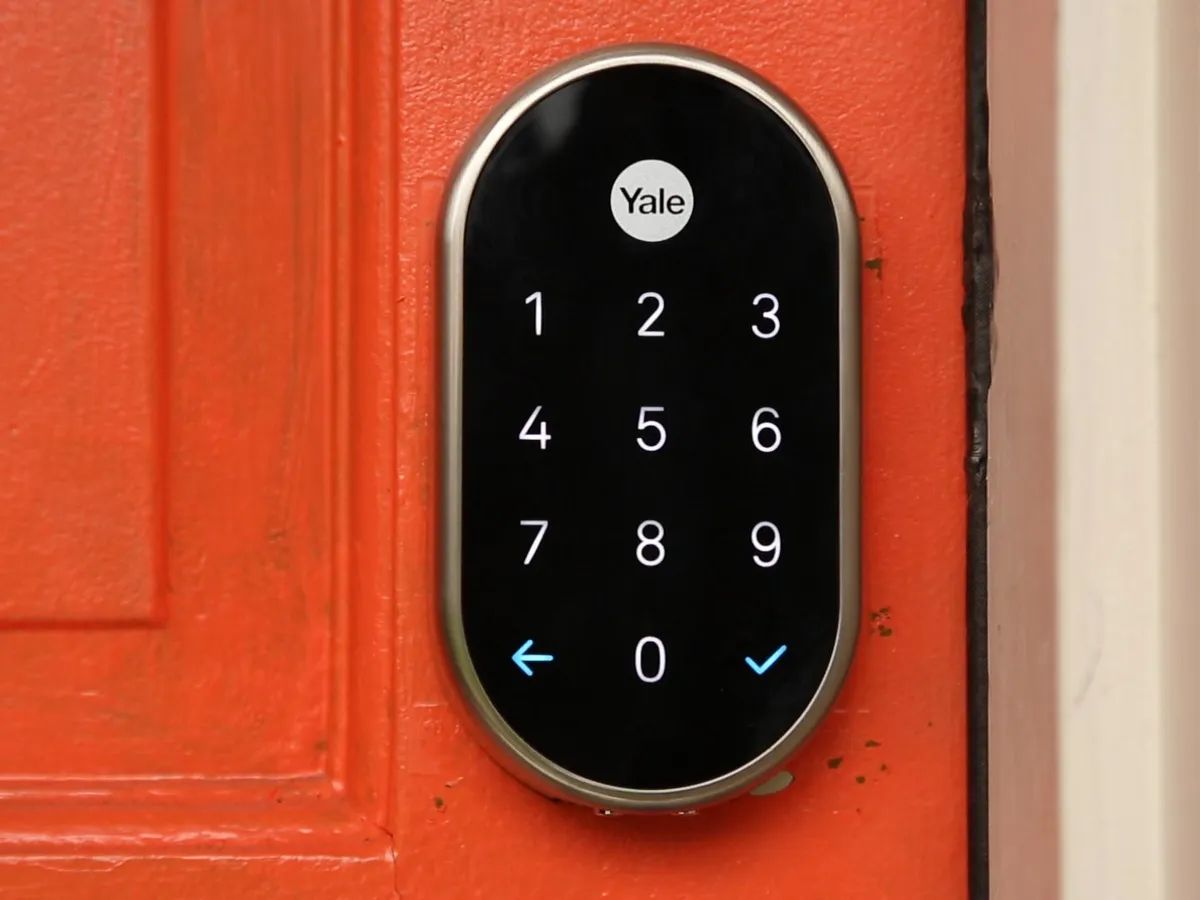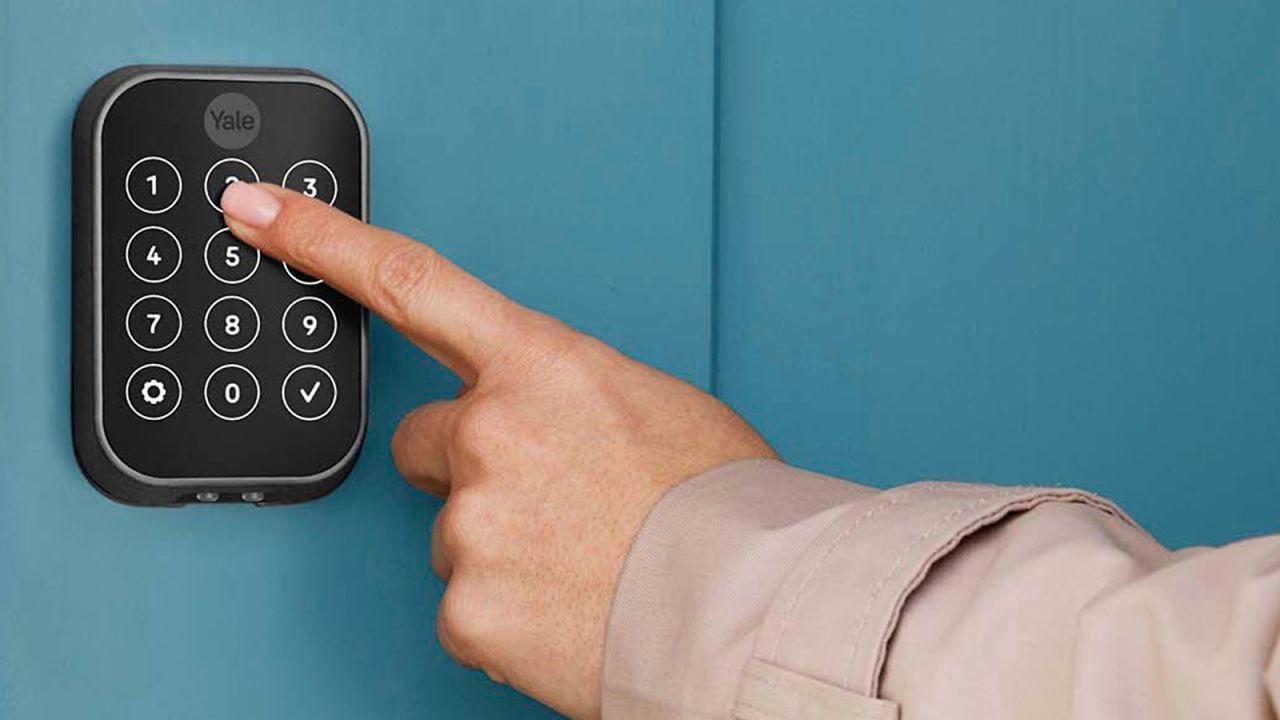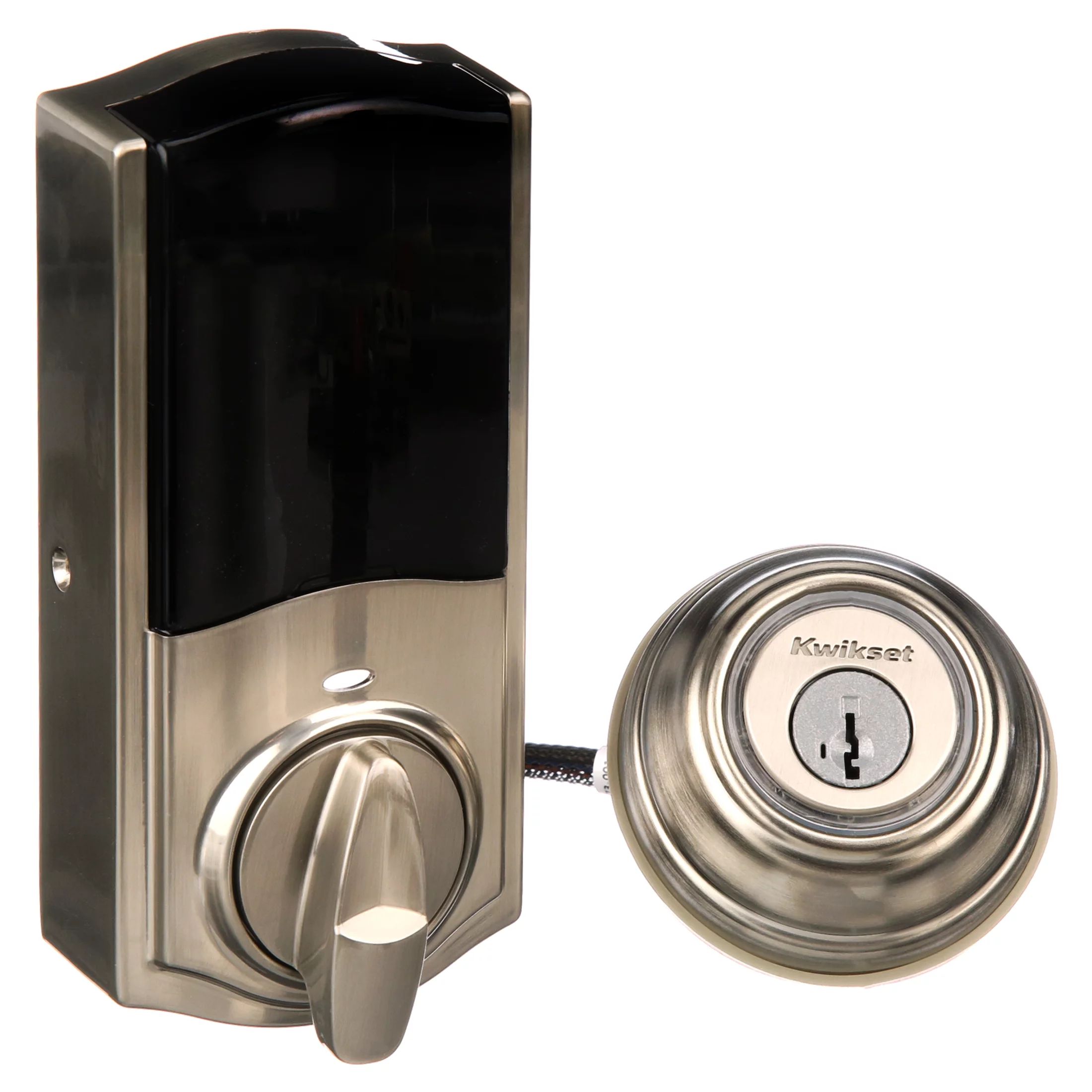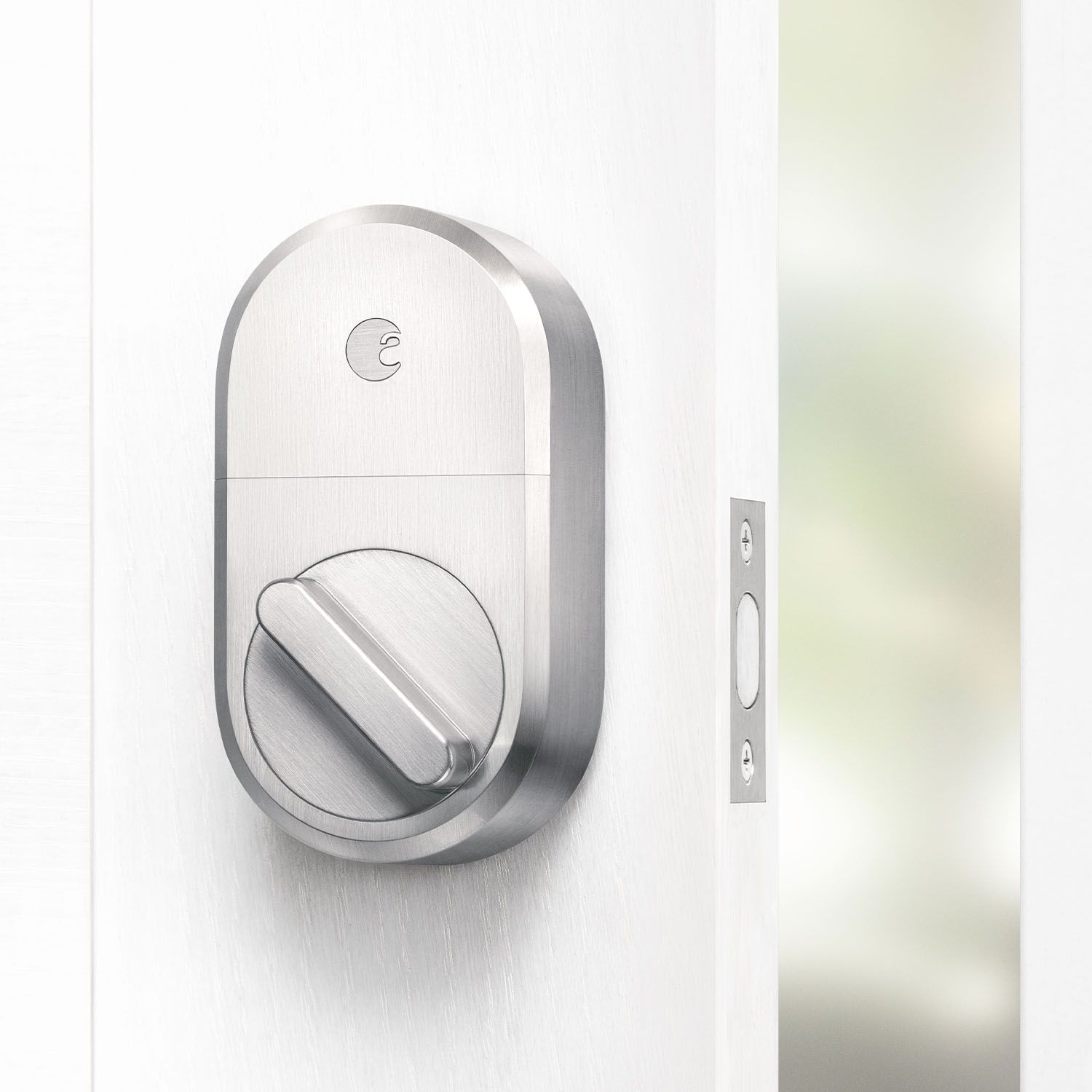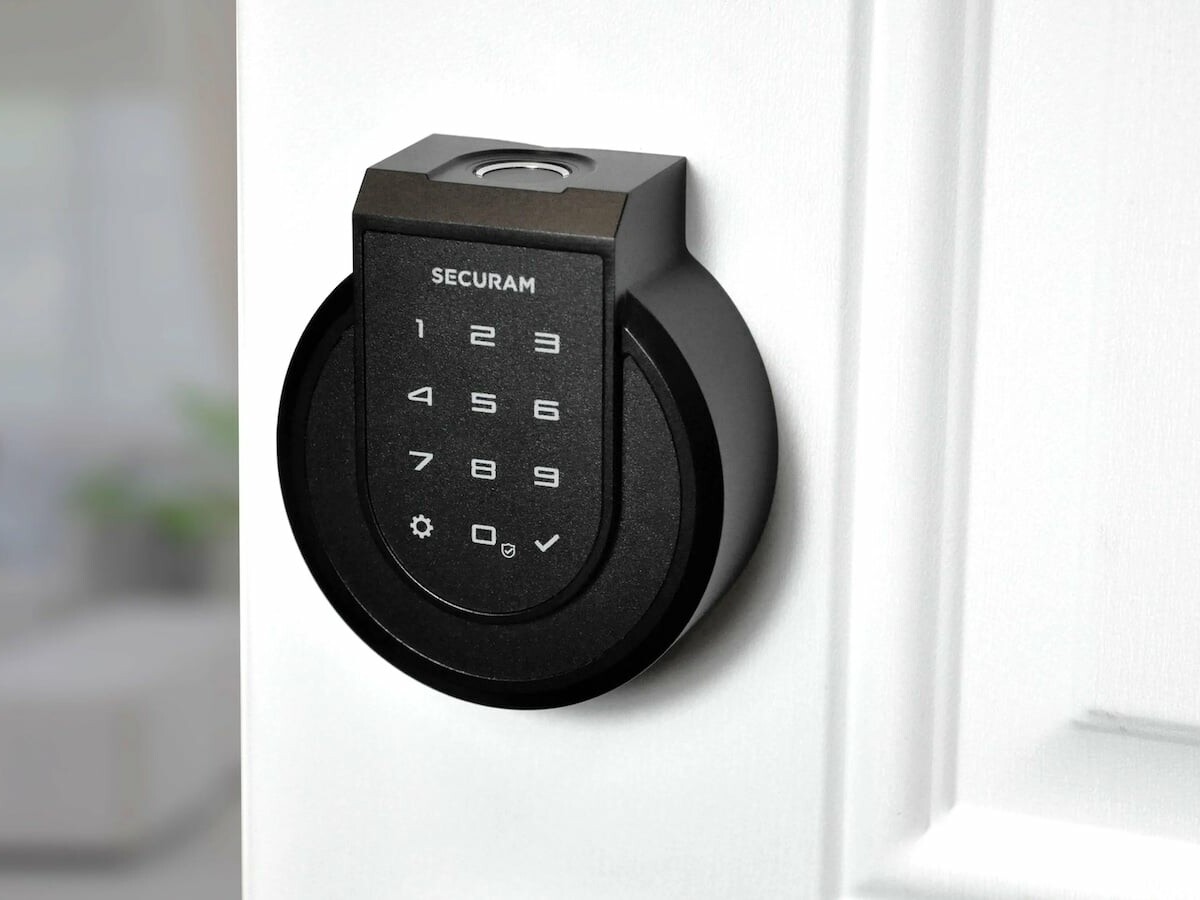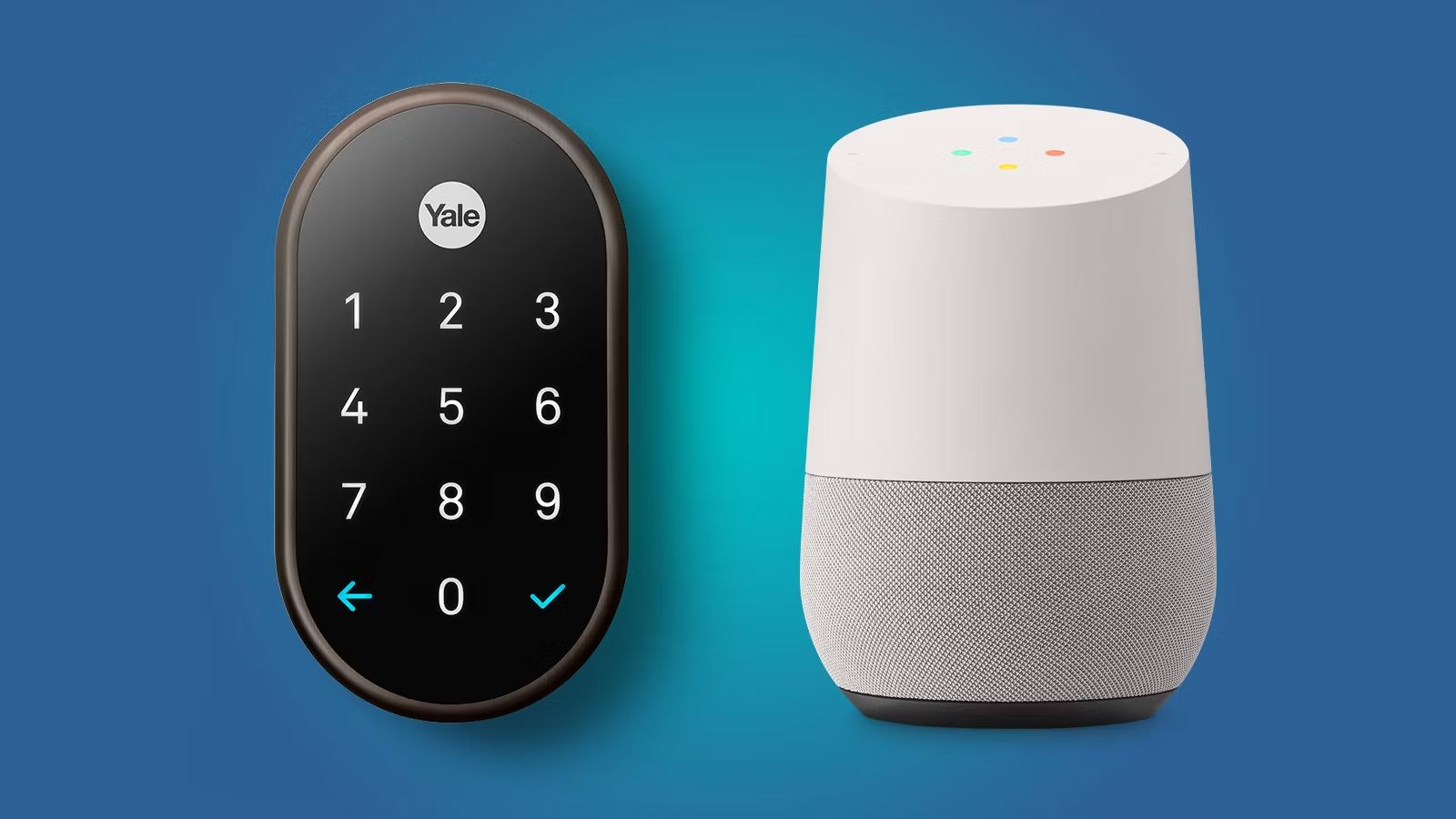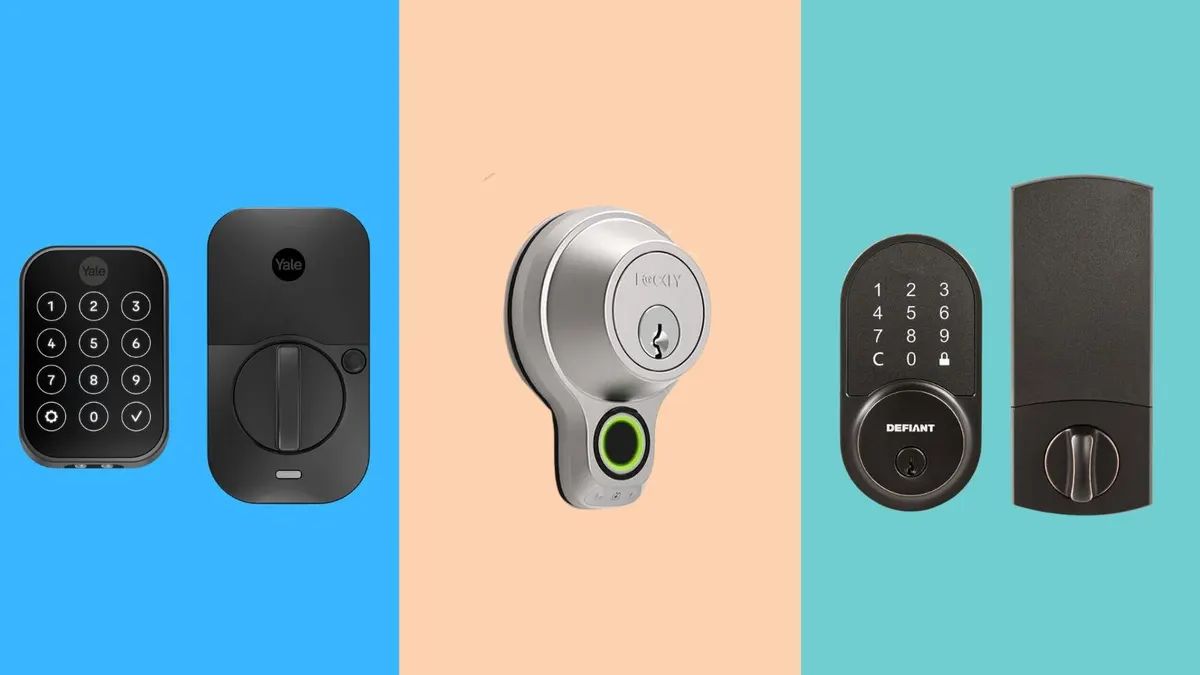Introduction
A smart door lock is a revolutionary technological solution that offers enhanced security and convenience for homeowners. With the advancement of the Internet of Things (IoT), traditional door locks are being replaced by intelligent and connected devices that provide users with remote access control and monitoring capabilities.
Gone are the days of fumbling for keys or worrying about lost or stolen keys. A smart door lock utilizes cutting-edge technology to provide a seamless and secure entry experience. Whether you’re at home or away, a smart door lock allows you to control access to your house with just a few taps on your smartphone or by using biometric authentication.
This article will delve into the workings of a smart door lock, exploring its basic components, connectivity options, security features, authentication methods, and more. By the end, you’ll have a comprehensive understanding of how these innovative devices operate and the benefits they offer.
So, let’s dive in and explore the fascinating world of smart door locks!
Understanding the basics of a smart door lock
A smart door lock is a keyless entry system that replaces traditional lock and key mechanisms with advanced technology. It provides users with various methods to unlock their doors securely, such as using a smartphone app, Bluetooth connection, keypad entry, or even facial recognition.
At its core, a smart door lock consists of several key components. The most important part is the physical locking mechanism, which is responsible for securing your door. This mechanism can be motorized or use a motor to operate the bolt, allowing for remote locking and unlocking.
Connected to the physical locking mechanism is the brain of the smart lock – the control unit. This unit processes commands from the user, communicates with other devices, and manages the overall functioning of the lock. It is typically powered by batteries or can be hardwired to your home’s electrical system.
In order to interact with the smart door lock, users have different options available. One common method is through a dedicated smartphone app. By connecting the lock to your smartphone via Bluetooth or Wi-Fi, you can unlock or lock your door from anywhere, monitor access activity, and receive notifications about who is coming and going.
Another popular method is keypad entry. A numeric keypad is integrated into the lock itself, allowing authorized individuals to enter a unique code to unlock the door. This method is particularly useful for households with multiple family members or when granting temporary access to guests or service providers.
Additionally, some smart door locks offer biometric authentication, such as fingerprint scanning or facial recognition. These methods provide an extra layer of security, ensuring that only authorized individuals can gain access to your home.
Overall, the basic idea behind a smart door lock is to provide a secure and convenient entry solution. By eliminating the need for physical keys, homeowners can enjoy added flexibility, increased control, and improved peace of mind when it comes to the security of their homes.
Key components and features of a smart door lock
A smart door lock is a complex device that combines hardware and software components to provide advanced security and convenience features. Understanding the key components and features of a smart door lock is crucial to selecting the right one for your home.
1. Locking Mechanism: The physical locking mechanism is at the heart of a smart door lock. It can be a deadbolt or a latch bolt that extends and retracts to secure or release the door. Some smart locks can be retrofitted onto existing door locks, while others require a complete replacement.
2. Control Unit: The control unit is the brain of the smart door lock. It processes commands from the user and communicates with other devices or platforms. The control unit can be housed within the lock itself or located remotely, such as in a hub or a smart home security system.
3. Connectivity Options: Smart door locks can use various technologies to connect to other devices or the internet. Bluetooth, Wi-Fi, Z-Wave, or Zigbee are commonly used protocols. Bluetooth provides short-range connectivity, while Wi-Fi allows for remote access and control of the lock from anywhere with an internet connection.
4. Mobile App: Most smart door locks come with a companion mobile app. This app allows users to remotely control and monitor access to their homes. With the app, users can lock or unlock the door, grant or revoke access to users, receive notifications, and view access logs.
5. Keyless Entry Methods: One of the main advantages of smart door locks is the ability to eliminate the need for traditional keys. Keyless entry methods include using a smartphone app, keypad entry, biometric authentication (fingerprint or facial recognition), or even voice commands.
6. Integration with Smart Home Systems: Many smart door locks can integrate with popular smart home systems, such as Amazon Alexa, Google Assistant, or Apple HomeKit. This integration allows users to control the lock using voice commands or automate their access control based on other smart devices or routines.
7. Security Features: Smart door locks are designed with robust security features to protect your home. These may include advanced encryption, tamper alerts, auto-locking capability, and temporary access codes. Look for locks that comply with industry standards and receive regular firmware updates to ensure ongoing security.
8. Battery Life: Smart door locks are battery-powered, so it’s essential to consider the battery life of the lock. Look for locks that offer long battery life or have low battery alerts, ensuring your lock remains operational without frequent battery changes.
By understanding these key components and features, you can make an informed decision when selecting a smart door lock that meets your security needs and fits seamlessly into your smart home setup.
How does a smart door lock connect to the internet?
A crucial aspect of a smart door lock is its ability to connect to the internet, enabling remote access and control. There are several ways a smart door lock can establish an internet connection, each with its own advantages and considerations.
1. Wi-Fi Connectivity: Many smart door locks utilize Wi-Fi connectivity to connect directly to the internet. This type of connection provides the most convenient and seamless access to the lock from anywhere with an internet connection. However, it’s important to ensure that the lock is within range of your Wi-Fi network and that your network has adequate security measures in place.
2. Bluetooth: Bluetooth is another popular method for connecting smart door locks. Bluetooth allows for short-range connections between the lock and your smartphone or other devices. This type of connectivity is useful if you want to control the lock within close proximity. However, it does have limitations in terms of range, requiring you to be physically near the lock for it to work.
3. Z-Wave or Zigbee: Z-Wave and Zigbee are wireless communication protocols specifically designed for smart homes. Smart door locks that support these protocols can connect to a smart home hub or gateway, which acts as a central control point for all connected devices. This hub then connects to the internet, allowing remote access and control of the lock via smartphone apps or other devices.
4. Cellular Connection: Some smart door locks come equipped with a built-in cellular chip, similar to a smartphone. These locks use cellular networks (e.g., 4G or LTE) to connect to the internet independently, eliminating the need for a Wi-Fi network or hub. This type of connection ensures that the lock remains accessible even if the Wi-Fi or power is down, but it may require a separate data plan.
Once a smart door lock is connected to the internet, it can be controlled and monitored remotely through a dedicated mobile app. This app allows you to lock or unlock the door, receive notifications about access activity, and grant or revoke access for users.
It’s important to note that when setting up a smart door lock, you should follow the manufacturer’s instructions for connecting it to the internet securely. This may include setting up strong passwords, enabling two-factor authentication, and updating the lock’s firmware regularly to protect against security vulnerabilities.
Communication protocols used by smart door locks
Smart door locks rely on various communication protocols to connect and interact with other devices in a smart home ecosystem. These protocols determine how the lock communicates with a hub, smartphone app, or other devices, ensuring seamless integration and functionality. Let’s explore some of the commonly used communication protocols in smart door locks.
1. Wi-Fi: Wi-Fi is a widely adopted communication protocol that enables smart door locks to connect directly to your home’s Wi-Fi network. Wi-Fi connectivity offers the advantage of remote access and control from anywhere with an internet connection. It is important to ensure that your lock utilizes the latest Wi-Fi standards for optimal speed and security.
2. Bluetooth: Bluetooth is a short-range wireless technology that is often used for local communication between a smart door lock and a smartphone or other nearby devices. Bluetooth allows for convenient and secure access control, but it typically has limited range compared to Wi-Fi.
3. Z-Wave: Z-Wave is a wireless communication protocol specifically designed for smart home devices. Smart door locks that support Z-Wave can connect to a Z-Wave hub or controller, allowing integration with other Z-Wave devices in the home. Z-Wave provides a reliable and secure mesh network, ensuring that commands reach the lock even if direct communication is obstructed.
4. Zigbee: Zigbee is another widely used wireless communication protocol for smart home devices. Similar to Z-Wave, Zigbee allows smart door locks to connect to a Zigbee hub or coordinator. Zigbee operates on a low-power mesh network, enabling efficient and secure communication between devices while conserving energy.
5. Thread: Thread is a wireless protocol that uses IPv6 connectivity for device-to-device communication. It is designed for low-power, secure, and reliable connectivity, making it suitable for smart home applications. While not as widely adopted as Wi-Fi or Zigbee, some smart door lock manufacturers are starting to adopt Thread for their products.
6. NFC (Near Field Communication): NFC is a short-range wireless technology often used for contactless payments and secure access control. Some smart door locks support NFC, allowing users to unlock the door by tapping a compatible device, such as a smartphone or a key fob, against the lock.
When selecting a smart door lock, it is essential to consider the communication protocol it uses and ensure compatibility with your existing smart home infrastructure or the devices you plan to integrate in the future.
Each communication protocol has its own advantages and considerations, including range, power consumption, interoperability, and availability of compatible devices. It is important to research and select a smart door lock that supports the communication protocol(s) best suited to your needs and preferences.
How secure are smart door locks?
Security is a top concern when it comes to smart door locks. Homeowners want to ensure that their doors are effectively protected against unauthorized access and potential vulnerabilities. So, just how secure are smart door locks? Let’s explore the security measures commonly found in these devices.
Encryption: Smart door locks utilize encryption to protect the communication between the lock and other devices, such as the smartphone app or the smart home hub. Encryption algorithms, such as AES (Advanced Encryption Standard), ensure that the data transmitted is secure and cannot be easily intercepted or deciphered.
Authentication: To ensure that only authorized users can control the lock, smart door locks employ various authentication methods. These can include PIN codes, biometric authentication like fingerprint or facial recognition, or using a smartphone’s secure authentication mechanisms like fingerprints or face unlock.
Lock Tampering Alerts: Many smart door locks come equipped with tamper detection mechanisms that can detect and alert users if someone is attempting to tamper with the lock. This can include detecting forced entry attempts or tampering with the lock’s internal components.
Two-Factor Authentication: Some smart door lock systems offer an additional layer of security via two-factor authentication. This means that in addition to a password or PIN code, users will need to provide another form of authentication, such as a fingerprint scan or a unique physical key, to unlock the door.
Temporary Access: Smart door locks often allow homeowners to grant temporary access to others, such as guests or service providers. This feature ensures that access can be limited to specific time periods, reducing the risk of unauthorized access after the temporary access period has ended.
Regular Firmware Updates: Manufacturers of smart door locks typically release firmware updates to address any security vulnerabilities or improve the overall performance of the lock. It’s important to regularly update the lock’s firmware to ensure that you have the latest security patches.
While these security measures provide a significant level of protection, it is essential to note that no system is entirely foolproof. Like any other connected device, smart door locks can still be vulnerable to certain security risks, such as hacking attempts or exploits targeting software vulnerabilities. Therefore, it’s important to choose a reputable and trusted brand and follow best practices for securing your smart home network, such as using strong passwords and regularly updating all connected devices.
Ultimately, with proper configuration and adherence to security best practices, smart door locks can provide a high level of security for your home, offering convenience without compromising safety.
How does a smart door lock authenticate users?
A crucial aspect of smart door locks is their ability to authenticate users accurately and securely. By verifying the identity of individuals attempting to gain access, smart door locks help ensure that only authorized users can enter the premises. Let’s explore the various authentication methods used by smart door locks.
1. PIN Codes: One of the most common authentication methods is the use of PIN codes. Users can input a unique numerical code using a keypad integrated into the lock or through a smartphone app. The lock verifies the entered code against a pre-registered list to grant or deny access. This method is widely used and provides a convenient way to authenticate users.
2. Biometric Authentication: Many modern smart door locks incorporate biometric authentication methods, such as fingerprint scanning or facial recognition. This technology verifies the unique biological traits of individuals to authenticate their identity. Biometric authentication offers a high level of security and convenience as it eliminates the need for keys or memorizing PIN codes.
3. Smartphone Authentication: Smart door locks often provide the option to authenticate users through their smartphones. This can be achieved through various methods such as Bluetooth, NFC, or specialized mobile apps. The lock verifies the user’s smartphone as an authorized device to grant access. The convenience of using a smartphone for authentication makes this method popular among users.
4. Key Fobs or Cards: Some smart door locks support the use of key fobs or cards for authentication. These small proximity devices can be carried by users and presented to the lock to initiate the authentication process. This method offers quick and easy access for authorized individuals.
5. Voice Recognition: Advanced smart door locks may incorporate voice recognition technology to authenticate users. By analyzing the unique voice patterns of individuals, the lock can determine authorized users and grant access. However, voice recognition technology is less commonly found in smart door locks compared to other authentication methods.
In addition to these authentication methods, many smart door locks offer features like two-factor authentication, which requires users to provide multiple forms of authentication, such as a PIN code and a fingerprint scan or a smartphone and a voice command.
It’s worth noting that the availability of specific authentication methods may vary depending on the model and brand of the smart door lock. It’s essential to choose a lock that offers authentication methods that align with your preferences and security requirements.
By incorporating secure and reliable authentication methods, smart door locks ensure that only authorized individuals can access your home, providing peace of mind and enhanced security.
Unlocking methods supported by smart door locks
Smart door locks offer a range of unlocking methods to cater to different user preferences and convenience. These methods eliminate the need for traditional keys and provide alternative ways to unlock your door securely. Let’s explore some of the unlocking methods commonly supported by smart door locks.
1. Smartphone Apps: The most popular and convenient unlocking method is through a dedicated smartphone app. Smart door locks can connect to your smartphone via Bluetooth or Wi-Fi, allowing you to unlock or lock your door from anywhere with an internet connection. The app provides a seamless and user-friendly interface for controlling access to your home.
2. Keypad Entry: Many smart door locks include a built-in keypad on the lock itself. With this method, you can enter a unique PIN code on the keypad to unlock the door. Keypads are useful for granting access to family members or guests who may not have a smartphone or key fob.
3. Biometric Authentication: Some smart door locks support biometric authentication methods, such as fingerprint scanning or facial recognition. By scanning your fingerprint or recognizing your face, the lock verifies your identity and unlocks the door. Biometric authentication offers a high level of security and eliminates the need for keys or codes.
4. Proximity Unlocking: Proximity unlocking uses Bluetooth or NFC technology to automatically unlock the door when an authorized device, such as a smartphone or key fob, is in close proximity to the lock. This method provides a convenient “hands-free” experience, allowing you to enter your home effortlessly.
5. Voice Commands: With the advent of voice assistant technology, some smart door locks allow for unlocking through voice commands. By integrating with popular voice assistants like Amazon Alexa or Google Assistant, you can simply speak a command to unlock the door, making the process quick and convenient.
6. Physical Override Key: While the aim of smart door locks is to eliminate the need for physical keys, many models still provide a traditional key slot as a backup method. This allows you to unlock the door with a physical key in case of technical issues or emergencies.
It’s important to note that the availability of unlocking methods may vary depending on the specific model and brand of the smart door lock. When selecting a smart door lock, consider the unlocking methods that align with your preferences, lifestyle, and security needs.
Smart door locks provide flexibility and convenience by offering multiple unlocking methods. These methods cater to a range of user preferences, ensuring that you can enter your home easily while maintaining a high level of security.
The benefits of a smart door lock
Smart door locks offer a multitude of benefits that enhance both the security and convenience of your home. By replacing traditional locks with cutting-edge technology, smart door locks bring a host of advantages to homeowners. Let’s explore some of the key benefits of using a smart door lock.
1. Enhanced Security: One of the most significant advantages of smart door locks is the enhanced security they provide. With features like encryption, authentication, and tamper detection, smart door locks offer a robust defense against unauthorized access. You have peace of mind knowing that only authorized individuals can enter your home.
2. Convenience and Remote Access: Smart door locks allow you to control and monitor your door from anywhere. Using a smartphone app or other connected devices, you can remotely lock or unlock your door, grant access to guests or service providers, and receive notifications about door activity. You no longer need to rush home to let someone in or worry about lost keys.
3. Keyless Entry: Say goodbye to the hassle of carrying physical keys. With smart door locks, you can enjoy keyless entry into your home. Whether it’s using a smartphone app, keypad entry, or biometric authentication, you can enter your home effortlessly with just a few taps or a simple scan.
4. Temporary Access: Smart door locks enable you to grant temporary access to others. Whether it’s allowing a dog walker access for a specific time or providing entry to houseguests, you have control over who can enter your home and for how long. This eliminates the need to share physical keys or worry about unauthorized duplication.
5. Integration with Smart Home Systems: Smart door locks seamlessly integrate with other smart home devices and systems. You can connect them to voice assistants like Amazon Alexa or Google Assistant, integrate them with your home security system, or automate routines based on your presence or specific events. This integration enhances the overall smart home experience.
6. Auditing and Activity Logs: With smart door locks, you can keep track of who is entering and leaving your home. Many smart locks maintain detailed activity logs, allowing you to review access history. This provides valuable information for security purposes and helps you keep tabs on the comings and goings of your household.
7. Emergency Access: In emergency situations, smart door locks can provide quick and easy access. Whether it’s using a physical override key or granting emergency access remotely, you can ensure that help can enter your home when needed.
Overall, smart door locks offer a range of benefits that enhance the security, convenience, and control you have over your home’s access. With advanced features and seamless integration, these locks are transforming the way we secure and interact with our doors.
Considerations before buying a smart door lock
Before purchasing a smart door lock, it’s essential to consider a few key factors to ensure you choose the right lock for your specific needs. Each home and homeowner has unique requirements, so taking the time to evaluate these considerations will help you make an informed decision. Here are some important factors to consider:
1. Compatibility: Before buying a smart door lock, ensure that it is compatible with your existing door and lock type. Consider whether the lock requires a complete lock replacement or if it can be retrofitted onto your existing lock. Additionally, check whether the lock is compatible with your smartphone or smart home system.
2. Power Source: Consider the power source of the smart door lock. Some locks use batteries, while others require a constant electrical connection. Determine which power source is most convenient for you and whether the lock offers low-battery warnings or backup power options to prevent being locked out.
3. Security Features: Evaluate the security features of the smart door lock. Consider factors such as encryption, authentication methods, tamper detection, and firmware updates. Look for locks that meet industry security standards and choose a reputable brand that prioritizes security.
4. Connectivity Options: Assess the connectivity options of the smart door lock. Decide whether you prefer Wi-Fi, Bluetooth, Z-Wave, or another protocol that aligns with your smart home ecosystem. Consider factors such as range, reliability, and the availability of compatible devices and platforms.
5. User Experience and Interface: Evaluate the user experience and interface of the smart door lock. Research the mobile app used to control the lock and ensure it provides a user-friendly and intuitive interface. Read reviews and consider the ease of installation and setup process.
6. Budget: Set a budget for your smart door lock purchase. Prices can vary significantly based on the features, brand, and level of integration offered. Determine your budget and find a lock that offers the best combination of security and convenience within your price range.
7. Reviews and Reputation: Read customer reviews and research the reputation of the smart door lock manufacturer. Look for feedback on reliability, durability, and customer support. A reputable manufacturer with positive reviews is more likely to provide a quality product and satisfactory post-purchase support.
8. Installation: Consider the installation process of the smart door lock. Evaluate whether you feel comfortable installing the lock yourself or if professional installation is required. Some locks are designed for DIY installation, while others may require the assistance of a locksmith or a professional installer.
By carefully considering these factors, you can ensure that the smart door lock you choose is compatible, secure, user-friendly, and meets your budget and installation requirements. Taking the time to evaluate these considerations will help you make an informed decision and select a smart door lock that perfectly suits your needs and enhances the security and convenience of your home.
Conclusion
Smart door locks have revolutionized the way we secure and interact with our homes. With advanced technology and innovative features, these locks offer enhanced security, convenience, and control. From keyless entry methods to remote access and monitoring capabilities, smart door locks provide homeowners with a range of benefits that traditional locks cannot match.
By understanding the basics of how smart door locks work, the key components and features they offer, and the various authentication and unlocking methods available, you can make an informed decision when choosing the right smart door lock for your home.
Considerations such as compatibility, security features, connectivity options, user experience, budget, and installation are crucial in selecting the ideal smart door lock that meets your specific needs and requirements.
It’s important to remember that while smart door locks offer tremendous advantages, no security system is perfect. It is essential to choose reputable brands, follow best practices for securing your smart home network, and regularly update firmware to ensure ongoing protection.
With proper installation, configuration, and use, smart door locks provide a high level of security, convenience, and peace of mind for homeowners. By embracing this smart home technology, you can take control of your home’s access, streamline entry methods, and enhance the overall security of your living space.
As the technology continues to evolve, we can expect even more advanced features and integration options from future generations of smart door locks. The possibilities are limitless, making the smart door lock an integral part of the modern smart home ecosystem.







